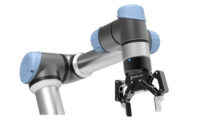This February will mark my 25th anniversary with ASSEMBLY magazine. In that short time, I’ve seen technological advancements that I could not have imagined, and each day seems to bring news of another.
Last month, Mercedes-Benz literally and figuratively blew my mind. During the IAA Mobility show in Munich in September, Mercedes-Benz displayed its battery-powered Vision AVTR concept vehicle, which features a brain-controlled interface (BCI). After a short calibration process, a BCI device attached to the driver’s head measures and analyzes his brain waves and triggers a defined function.
“Mercedes-Benz is setting another milestone in the merging of man and machine with the research and development of brain-computer interface applications in cars,” says Britta Seeger, a member of the board of management at Daimler AG. “BCI technology has the potential to further enhance driving comfort in the future. [It] works completely independently of speech and touch. This opens up revolutionary possibilities for intuitive interaction with the vehicle.”
At the IAA show, Mercedes demonstrated a seat mockup of the Vision AVTR. For this purpose, dots of light are projected onto a fully digital dashboard, and a virtual world is displayed on a screen in front of the windshield. A BCI device with wearable electrodes attached to the back of the driver’s head records brain activity and establishes a direct connection to the vehicle after a one-minute calibration. The brain reacts to the visual stimuli on the dashboard. The BCI device measures neuronal activity at the cortex in real time. It analyzes the measured brain waves and recognizes which light points the driver focuses his full attention on. The stronger the focus, the higher the neuronal activity. The device then triggers the targeted function in the vehicle.
For the purposes of the demo, drivers can use the power of their thoughts to perform various functions in the virtual world displayed through the windshield. For example, they can generate wind, grow plants, select a parking space, or turn day into night.
In the real world, however, drivers might tell an autonomous vehicle—through brain waves—to slow down, speed up, adjust the interior temperature, or take them home.
“With the development of our ‘Hey Mercedes’ voice assistant and the zero-layer concept of the MBUX Hyperscreen, we’ve already simplified vehicle operation radically,” says Markus Schäfer, head of research for the Daimler Group and chief operating officer of Mercedes-Benz Cars. “BCI technology can make it possible to relieve the user even more…to focus on the driving experience.”
Besides BCI technology, the Vision AVTR concept car is notable for other reasons. Its stretched “one-bow” design combines exterior and interior into an emotional whole. Sustainable materials are featured throughout the vehicle, including Karuun, a fast-growing rattan, and Dinamica, a leather-like upholstery made from recycled materials. Even the battery is made from organic, compostable materials. Thirty-three aps on the back of the vehicle can communicate with the outside world, with and through the driver, using naturally owing movements. Instead of a conventional steering wheel, the AVTR has a multifunctional control element in the center console. By placing a hand on the control, the interior comes to life and the vehicle recognizes the passenger by his heart rate. When the driver raises his hand, a menu is projected onto the palm, offering choices between functionalities.
I don’t know that BCI technology for cars is all that necessary, honestly. Is it that much work to turn a knob or press a button? Nevertheless, it’s interesting technology. What will we think of next?



